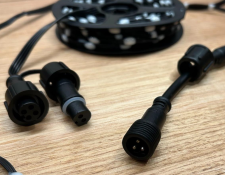Hi everyone,
Back in 2010 I installed a 10m “Dream Color” LED strip kit from AliExpress on my roofline (two parallel 4.6m strips powered from the attic peak, no long leads or power injection needed). It worked great, but now I’d like to replace and extend the setup to ~25.5m and upgrade to pixel seeds instead of strips.
Goals / Requirements:
Pixel density similar to what I have now (30 LEDs/m).
Total length: ~25.5m.
Clean, weatherproof install on wooden soffits (no vinyl/tin to hide wires).
Current plan:
Use pixel seeds (though I hear 25–30mm pitch seeds can be tricky to solder/connect).
Run heavy-gauge power wire and a data line from attic peak to the start of the run (4.6m away). Extend heavy-gauge wire another ~21m to the far end of the pixel run.
Add small extensions in the pixel run at 9.2m, 14.4m, and 21.9m to get around corners.
Splice power injection at those extension points.
Use DIY connectors that allow splicing heavy-gauge and pixel power wires directly inside the connector body (to avoid dropping down to 18AWG like with standard xConnect pigtails and keep power/pixel lines evenly segmented).
Bundle power + pixel wires together with tape/heat-shrink for a clean install.
Questions:
Is this plan feasible for a 25.5m pixel seed run?
What gauge of power wire would you recommend for parallel runs — would 12AWG copper-clad aluminum be sufficient, or should I go heavier (solid copper)?
What’s the best way to construct and waterproof the connections/extensions/power injection points while keeping them neat and segmented for easy installation and replacement?
Any recommendations for connectors that meet these requirements, allow splicing power and pixel wires in the connector body and will work with the short tails of 25mm/30mm pitch seeds?
Any recommendations for reliable pixel seeds and AliExpress sellers? (Some strings advertise 20AWG wire, which seems helpful for voltage drop.)
Thanks a ton for your help!
Back in 2010 I installed a 10m “Dream Color” LED strip kit from AliExpress on my roofline (two parallel 4.6m strips powered from the attic peak, no long leads or power injection needed). It worked great, but now I’d like to replace and extend the setup to ~25.5m and upgrade to pixel seeds instead of strips.
Goals / Requirements:
Pixel density similar to what I have now (30 LEDs/m).
Total length: ~25.5m.
Clean, weatherproof install on wooden soffits (no vinyl/tin to hide wires).
Current plan:
Use pixel seeds (though I hear 25–30mm pitch seeds can be tricky to solder/connect).
Run heavy-gauge power wire and a data line from attic peak to the start of the run (4.6m away). Extend heavy-gauge wire another ~21m to the far end of the pixel run.
Add small extensions in the pixel run at 9.2m, 14.4m, and 21.9m to get around corners.
Splice power injection at those extension points.
Use DIY connectors that allow splicing heavy-gauge and pixel power wires directly inside the connector body (to avoid dropping down to 18AWG like with standard xConnect pigtails and keep power/pixel lines evenly segmented).
Bundle power + pixel wires together with tape/heat-shrink for a clean install.
Questions:
Is this plan feasible for a 25.5m pixel seed run?
What gauge of power wire would you recommend for parallel runs — would 12AWG copper-clad aluminum be sufficient, or should I go heavier (solid copper)?
What’s the best way to construct and waterproof the connections/extensions/power injection points while keeping them neat and segmented for easy installation and replacement?
Any recommendations for connectors that meet these requirements, allow splicing power and pixel wires in the connector body and will work with the short tails of 25mm/30mm pitch seeds?
Any recommendations for reliable pixel seeds and AliExpress sellers? (Some strings advertise 20AWG wire, which seems helpful for voltage drop.)
Thanks a ton for your help!



